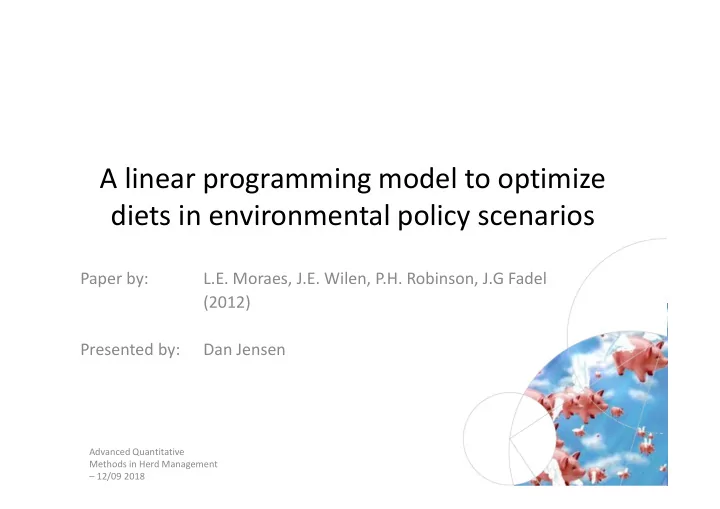

A linear programming model to optimize diets in environmental policy scenarios Paper by: L.E. Moraes, J.E. Wilen, P.H. Robinson, J.G Fadel (2012) Presented by: Dan Jensen Advanced Quantitative Methods in Herd Management – 12/09 2018
Introduction • Problem: (Dairy)-farming is messy! • Agriculture: 6.3 % total US GHG emissions (2009) • Enteric fermentation ( �� � ): 20 % of US human GHG • Also nitrogen, phosphor, etc. • Goal: Tool for optimizing dairy cattle diet • Effect of emission taxes • Forced (assumed) reduction • Status of this research: Preliminary! • Sensitive to constraints. E.g. feed prices Dias 2
Methods General Background • Linear Programming Model (LPM) • Reminder - an LPM is: • Method to achieve best outcome given certain constraints • Constraints are represented by linear relationships Dias 3
Methods The models • Three scenarios – three models: • BASEM: Cheapest possible feed (baseline) • TAXM: what if there was an emission tax? • … of 5 $ per tonne? • … of 17 $ per tonne? • … of 250 $ per tonne? • REDM: what if you were forced to reduce emissions? Dias 4
Methods The models, Assumptions 1 � � − � � Dias 5
Methods The models, Assumptions 2 � � − � �� � � − � �� � � − � �� kg/kg DM $/kg DM Locally collected Dias 6
Methods The models, Assumptions 2.1 Dias 7
Methods The models, specifics • BASEM/REDM: Remember: j = feed c = cost of feed a = animal class Dias 8
Methods The models, specifics • TAXM: Remember: j = feed c = cost of feed a = cow category �� � Notice: e = expected emission (tonnes) p = tax price per tonne �� � Dias 9
Methods The models, Outputs • How big is the mess? 55.65 MJ/kg Feed composition – absorbstion � Excrete composition Dias 10
5 minute break
Methods The models, Constraints 1 Other Limits, 1 Diet. Feed Limits Nutrient req . DMI Diet. Barley Limits Other Limits, 2 Diet. Forage Proportions Methane Restrictions Dias 12
Methods The models, Constraints 2 7 x 14 = 98 eq. Nutrient req . Amount Requirement Nutrient content Remember: j = feed a = cow category (7 kinds) i = nutrient (14 kinds) Dias 13
Methods The models, Constraints 3 Diet. Feed Limits 7 x 10 = 70 eq. �� � �� ≤ � �� ∙ � � �� ��� Remember: j = feed a = cow category (7 kinds) l = limit (for 10 kinds of j ) Dias 14
Methods The models, Constraints 4 Methane Restrictions (REDM) Total feed Max. (all cows, all feed) Emission 1-Reduction Total NDF Total ME Methane BASEM prediction emission Dias 15
Results Neutral Detergent Fiber consumption given Metabolisable energy Methane reduction • REDM: proportion given Crude protein consumption Methane reduction given Methane reduction Dias 16
Results • REDM: ↓ �� � → ↓ ���� ! ∴ ↓ �� � → ↑ $�%�! Dias 17
Results • REDM: Consumption Excretion Dias 18
Results • Shadow prices, Feed stuff: �%&!� �'( )��*!%' )�%�!+: -.)��*!'* /�� �-0� �!(1�*%�'+ Dias 19
Results • Shadow prices, Methane emissions: Dias 20
Conclusions • Cost of low emission diet exceeds cost of taxes � TAXM ~ BASEM • Reduction of �� � emissions yields increase in Nitrogen-excretion • Further studies are needed! Dias 21
Recommend
More recommend